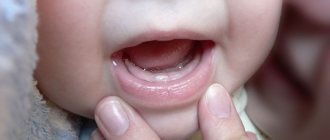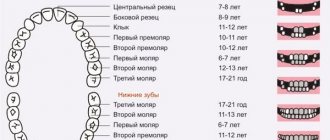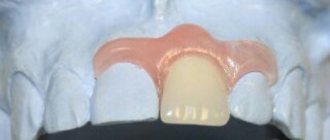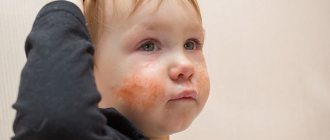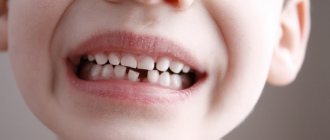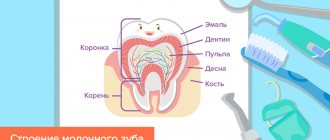How many baby teeth do children have?
Milk teeth and even some molars begin to form at the stage of intrauterine development. Of course, a child has no visible teeth at birth - they begin to erupt only after 6 months. During this six-month period, they are hidden under the gums, but slowly develop and form, beginning to move outward.
In total, a child grows 20 baby teeth:
- Central and lateral incisors – 8.
- Fangs – 4.
- First and second molars – 8.
Their main function is to form a space where molars will then grow.
When is it time to see a dentist?
Those parents whose children can boast of their first milk teeth as early as 4–5 months should not worry, in fact, neither should those whose children began to erupt only closer to 7–9 months. But if there are no teeth at all at 1 year, then this should be a reason to immediately consult a doctor. It is also necessary to undergo a consultation if the baby’s teething order is disrupted, for example, molars or canines appear first, and not the incisors. Or if the units do not erupt in pairs.
What other deviations from the norm should be a reason for a visit to the clinic? If the child was born with teeth or they appeared during the first month of life. Some parents are looking for information about how many teeth they should have per year, and some are surprised that their baby is born with only 1-2 teeth. The cause of this pathology can be diseases suffered by a woman during pregnancy. In the future, the problem can lead to too early or, conversely, late loss of milk units and malocclusion. The decision whether to remove or preserve such units is made by the doctor.
Important! The doctor will order an examination to determine exactly what caused this or that deviation from the norm. For treatment, a specialist can prescribe vitamins and medications, orthodontic and orthopedic structures. A timely visit to the dentist will help prevent the development of complications and the transition of pathology to a more severe stage.
How many teeth should a child have per year?
During this period, baby teeth begin to cut.
They begin to break out in the following sequence on the upper and lower jaws. On the top:
- 8-12 months. Central incisors.
- 9-13 months. Lateral incisors.
- 16-22 months. Fangs.
- 13-19 months. First molars.
- 25-33 months. Second molars.
In the lower jaw, this process is distributed in time somewhat differently:
- 6-10 months. Central incisors.
- 10-16 months. Lateral incisors.
- 17-23 months. Fangs.
- 14-18 months. First molars.
- 23-31 months. Second molars.
It is worth noting that these time limits are averaged and deviations up or down by 1-3 months are considered normal.
If you want to know how many teeth a child has per year is considered normal, you should refer to the chart described above. You get that at the age of 12 months there should be 6-8 of them.
What factors influence the speed of eruption?
If a child is ahead of the teeth growth pattern for up to a year or, conversely, is behind it, this does not mean that he has problems. This may be caused by heredity. But other factors can also influence the timing of eruption.
Diseases of a pregnant woman
The rudiments of teeth are formed already in the first trimester of pregnancy. If during this period the expectant mother ate poorly, smoked, or suffered from viral and infectious diseases (flu, rubella), then this can lead to a delayed eruption of the first units. Anomalies can also occur if a woman has serious chronic and systemic diseases (diabetes mellitus, for example).
Other complications of pregnancy can also play a role in the formation of the fetus: prolonged toxicosis, hypoxia, Rh conflict between mother and child. Early birth, when the baby is born premature, as well as birth injuries have an impact.
Child's diseases
Metabolic disorders, acute deficiency of minerals (especially calcium and vitamin D), problems with the thyroid gland and gastrointestinal tract, infections, vitamin deficiency and rickets in the first months of a baby’s life - all these are factors that influence the rate of eruption of milk, and then permanent units.
On a note! Even ecology and climate can influence the timing of eruption. Thus, according to some studies, in regions with a hot climate, where there is a lot of sun and warmth, children’s first teeth appear faster.
Some researchers believe that the timing1 of teething is also influenced by the type of feeding of a child up to one year. In babies who receive breast milk, temporary units erupt earlier than in those who are bottle-fed (BF) and eat formula. Children who are on breastfeeding have greater activity of the masticatory muscles, which contributes to more rapid formation and development of the maxillofacial apparatus.
Changing baby teeth to molars
Around the age of 4, a child’s growth spurt begins, the jaws enlarge and the baby teeth seem to move apart, with gaps appearing between them – trema. If this does not happen and by the age of 5 the teeth are still tight, you need to show the child to the dentist, as there may not be enough space for permanent teeth.
At about 5-6 years of age, baby teeth begin to become loose and gradually fall out, which indicates that the molars are already beginning to grow underneath them. Usually this process of change lasts for 5-8 years and the final formation of the dentition occurs somewhere around 14-15 years.
This happens in the following order:
- 5-6 years – lower and upper incisors.
- 7-8 years – lower and upper lateral incisors.
- 8-10 years – upper and lower molars.
- 9-11 years – upper and lower canines.
- 11-13 years – upper and lower molars.
Milk teeth are replaced by permanent molars. Their number at the age of 14-16 years is 28. At the same time, the third molars (wisdom teeth) are already formed, but they begin to grow only after 18 years. True, not all people grow them. It all depends on individual characteristics.
“Why do other children already walk at 9 months, but mine is not yet?”
The development skills mentioned are indicative only. If a baby at nine months does not speak, crawls little or only crawls on its belly and does not try to get up, there is no need to worry. Every child is different and while we can help them develop, they learn new skills at their own pace and in their own time. In addition, already at 9 months of age, the difference in development between boys and girls becomes noticeable.
But if there is something that worries you, even the smallest thing, share your concerns with your baby’s pediatrician. Only the doctor will determine what is the norm for proper development for your baby, and what you need to pay attention to. Whether it is necessary to take a massage course to prepare for walking, sign up for a swimming pool to support immunity and sound sleep, introduce new educational games and work on hearing and speech, or on the fact that the child does not sit independently - the answers to these questions are individual and depend on many factors. A child never needs everything at once: listen to the recommendations of specialists.
*The ideal food for an infant is mother's milk. WHO recommends exclusive breastfeeding for the first 6 months. MAMAKO® supports this recommendation. Before introducing new foods into your baby’s diet, consult a specialist.
How many teeth should a child have?
It all depends on age. The maximum number of teeth in the period from birth to 5-6 years is 20 - these are milk teeth. Then, until the age of 15-16, the molars begin to erupt, pushing out the milk teeth. Ultimately, their number grows to 28.
The latest are the third molars. They grow only after 18 years of age, but not everyone has them.
It is worth noting that the period of formation and eruption of baby teeth is very individual. In some children, all 20 teeth grow by the age of 2, while in others - by 2.5 or later. Such delays within a year are considered normal and are not a developmental anomaly.
If teeth do not start cutting in the first year of the baby’s life, you should consult a doctor to find out the reasons.
To the list of posts
Timing of teething
One of the most common questions parents ask is: “How long does teething take for babies?” It is useful to know both the time frame for the appearance of the first tooth and the time frame for the eruption of all teeth. In general, teething is an ongoing process that occurs between 6 and 24 months of age. Although your baby has twenty baby teeth that will appear over the course of two years, teething fortunately only causes pain and irritation at the time the tooth is about to break through the gum. It is not known exactly how long it will take for a tooth to fully erupt, but on average experts say it can erupt within 1-7 days per tooth. However, teething symptoms usually only last a couple of days, so if your baby experiences discomfort for an extended period of time, it's safe to assume it's not teething.
Dangerous consequences of the problem when there are no teeth on time
For different children, the number of teeth at 1 year can vary from 4 to 8. If there are fewer of them, and they erupt significantly later than the dates indicated by WHO, then, most likely, the remaining units (molars and canines) will also be delayed.
The lack of milk elements by the time the baby begins to eat food, which must be chewed thoroughly, leads to problems: food is not chewed fully, individual units of the series are subject to excessive load, diseases of the gastrointestinal tract and dysfunction of the temporomandibular joint (temporomandibular joint) occur.
The defect can cause problems with speech and pronunciation of various sounds. If the order and timing of teething is violated, the child’s bite may be disturbed, and disproportion and asymmetry of the face may occur.
Helping your baby when his first teeth are cutting
The most difficult period in a baby's life is when his first incisors come out. For most children, this happens before they turn one. At 4–6 months, the baby’s behavior and mood can change dramatically due to the fact that the gums in the area of the erupting units become inflamed, painful and itchy. The baby becomes too capricious, refuses to eat, sleeps poorly, and his mouth is watering. Many attentive parents also notice that the baby begins to cough, has diarrhea and a runny nose. What to do in this situation? A number of rules must be followed.
Rule #1: Don't be nervous.
Children sense a change in the mood of their parents, especially their mother, and begin to be even more capricious. Give your baby maximum attention, do not show aggression or irritation.
Rule #2: Ease Teething Signs
Special cooling and anti-inflammatory gels (for example, “Kamistad Baby”) and teethers will help with this. Instead of teethers from the pharmacy, pieces of hard vegetables and fruits wrapped in a special mesh or gauze are suitable.
Rule No. 3. Closely monitor the child’s condition
Diarrhea, fever, runny nose and cough may well be signs of teething. But these symptoms may also indicate various viral and infectious diseases. If you suspect an acute respiratory viral infection or an intestinal infection, it is better to call an ambulance.
Reasons to call a doctor: fever, vomiting, loose stools more than 5-6 times a day (or if blood is found in the stool), frequent and opaque nasal discharge, a “barking” choking cough.
Rule No. 4. Carefully monitor personal and general hygiene
Wash your hands before applying gel to your baby's gums to relieve teething symptoms. Disinfect all objects that surround the baby, because he puts everything in his mouth. If hygiene is not observed, there is a risk of infection and the child may develop stomatitis.

